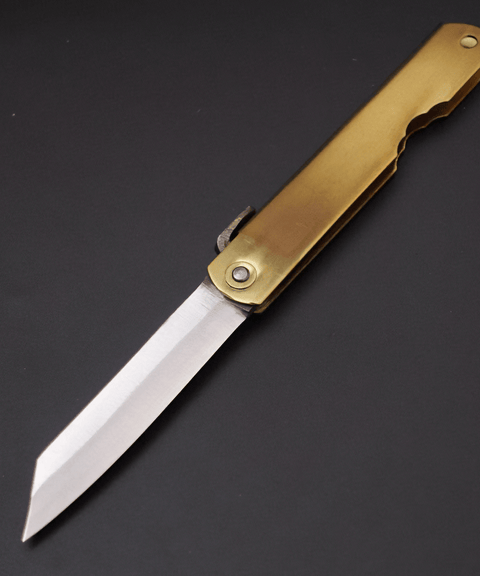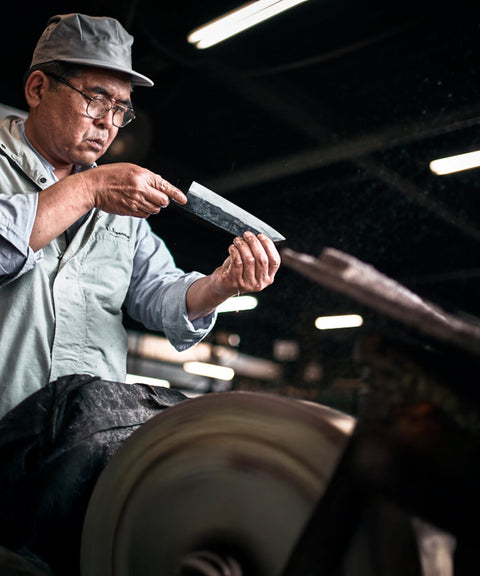
The Higonokami is an iconic folding knife in Japan , renowned for its simple yet effective design and deep connection to traditional craftsmanship. Since its origins in the Meiji era, it has been an essential tool in the daily lives of students, artisans, and farmers. Featuring a razor-sharp carbon steel blade and a non-locking friction mechanism, this knife has stood the test of time, maintaining its status as a symbol of precision and functionality.
👉 Discover authentic handmade Japanese knives in our store
Unlike modern folding knives with locking systems, the Higonokami opens and closes using a friction mechanism, allowing for intuitive and fluid use. Its compact design and extremely sharp edge make it a versatile tool, perfect for everyday tasks such as cutting rope, carving wood, or even sharpening pencils. Today, this piece of Japanese tradition remains prized by collectors and those seeking a simple, functional knife with great cultural value.
Origin and evolution of Higonokami
The Higonokami was born in Miki City, Hyogo , in the late 19th century, a region with a rich tradition of sword and cutting tool forging. During this period, Japan was undergoing major industrial and technological changes, but the need for a compact and accessible cutting tool led to the emergence of this type of knife.
Its name comes from "Higo," a reference to the ancient province of Kumamoto, and "no Kami," an ancient honorific title bestowed upon high-ranking officials. Upon its introduction to the market, the Higonokami became extremely popular among schoolchildren, artisans, and farmers, who used it for a wide variety of tasks.
However, in the mid-20th century, the introduction of new regulations in Japan restricted the use of knives and pocket knives in public spaces, leading to a decline in their production. Despite this, their legacy has lived on and in recent years has experienced a resurgence, both as an everyday tool and as a collectible.

Characteristics of Higonokami
The design of the Higonokami has remained virtually unchanged for over 100 years. Its structure is composed of three fundamental elements:
• Carbon steel blade : Traditionally made from Aogami (Blue Steel) or Shirogami (White Steel) , materials highly valued for their ability to maintain an extremely sharp edge.
• Brass or stainless steel handle : The handle is simple and without unnecessary embellishments, designed to provide durability and lightness at the same time.
• Non-locking friction mechanism : Unlike Western knives with safety mechanisms, the Higonokami uses a friction-based opening and closing system. It is operated with a tab called a chikiri , which allows the blade to be easily deployed.
Traditional and contemporary uses
Since its inception, the Higonokami has been a multipurpose tool in Japanese culture. Its most common applications include:
Traditional uses
• Cutting ropes and cords : Thanks to its sharp edge, it is ideal for precision tasks.
• Wood carving : Widely used by artisans and carpenters for small details in wood.
• Sharpening Pencils : Before pencil sharpeners were common, Japanese schoolchildren carried their Higonokami to sharpen their pencils.
Modern uses
• Collecting and art : With the resurgence of interest in Japanese handicrafts, Higonokami have gained popularity among collectors.
• Survival Knife (EDC - Everyday Carry) : Although not a combat knife, its compact size and sharp edge make it a useful tool for everyday activities.
• Gift item and cultural symbolism : Its traditional design and historical legacy have made it a meaningful gift for lovers of Japanese culture.
Looking for an authentic Japanese knife?
If after reading this you're looking for a traditional Japanese folding knife , we recommend you take a look at our collection of handmade Japanese folding knives.
In it you will find models such as:
-
🟡 Higonokami forged in brass , hand-sharpened in Japan
-
🔵 Kiridashi pocket : extreme minimalism for precision tasks
-
⚫ Modern Damascus knives , with pocket clip and stainless steel blade
All our knives are hand-sharpened, shipped within 24/48 hours from Spain, and retain the soul of Japanese cutlery.
👉 See the complete collection of Japanese knives
Legal Considerations on Higonokami
Although the Higonokami is a traditional knife, regulations regarding its use vary by country. In Japan, blade laws stipulate that:
• Knives or pocket knives with blades longer than 6 cm may not be carried without a justified reason.
• The Higonokami remains legal to own and use, but its transportation in public spaces is regulated.
In other countries, regulations vary depending on the blade size and type of safety mechanism. It's advisable to check local laws before purchasing one.
Higonokami: A jewel of Japanese cutlery
Despite the evolution of cutting tools and the arrival of more modern designs, the Higonokami remains a living testament to Japanese craftsmanship. Its simplicity, effectiveness, and timeless design make it a unique piece for both collectors and those seeking a practical knife with a history.
If you're interested in Japanese tradition and excellence in cutlery, the Higonokami is a must-have for any collection.
👉 Discover in our store the authentic Japanese handmade knives , hand-sharpened in Japan and ready to accompany you every day .











